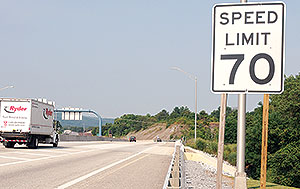Senior Reporter
Speed Limit Increases Responsible for Thousands of Extra Roadway Fatalities, Study Finds

A new study of maximum speed limit increases on U.S. roadways from 1993-2017 has concluded that more than 36,000 lives could have been spared if states had not increased their maximum speed limits over the 25-year period.
“The speed at which a motor vehicle is traveling affects both the likelihood of a crash and the severity of the crash,” said the Insurance Institute for Highway Safety study, made public this month. “All else being equal, increased speed increases the distance to stop or slow the vehicle in an emergency, and increased speed increases the energy of a collision.”
IIHS Report by on Scribd
The study’s author, Charles Farmer, vice president of research and statistical services for IIHS, estimated that for a 5 mph increase in a maximum speed limit, there is a corresponding 8.5% increase in fatality rates on interstates and freeways, and a 2.8% increase on other roads.
The study was based on overall U.S. fatality crash statistics, including both cars and trucks, as recorded in the National Highway Traffic Safety Administration’s Fatality Analysis Reporting System. “Higher speed limits can yield societal benefits through reduced travel time, but there is a price to pay in terms of additional lives lost,” the study said. “Those responsible for managing the roadway system must recognize and carefully consider this trade-off before deciding to increase speed limits.” The study said that maximum speed limits in the U.S. have vacillated over the years, but mostly trended upward since 2013.
In an update to a 2016 analysis, IIHS vice president for research and statistical services, Charles Farmer, estimates that rising speed limits over the past 25 years have cost nearly 37,000 lives. https://t.co/zvtmvWNjS8 pic.twitter.com/V2mmiEHeHo — IIHS (@IIHS_autosafety) April 15, 2019
In 1974, the federal government required the states to lower their maximum speed limits to 55 mph to conserve fuel. But by 1987 Congress passed a law allowing states to increase their speed limits to 65 mph. Then in 1995, the federal government repealed the congressional mandate and allowed states to set the top speeds for their highways, according to the study.
From 1993-2017, five states raised their maximum speed limits from 55 mph to 65 mph, a total of 41 states have raised their maximum limits to at least 70 mph, but top speeds remained constant at 65 mph in Alaska, Massachusetts and Vermont.
Why are maximum speed limits continuing to climb? Don’t blame state legislators, said Farmer, who has studied the impact of speed on highways for nearly 20 years.
“They’re political, but I think they’re really based on the public asking for them,” Farmer told Transport Topics. “Everybody likes to go fast, they want to save time. At least they feel like they’re going to save a lot of time if they raise the speed limit.”
The study conceded that motorists can reach their destinations quicker at higher speeds. However, it noted that the difference between traveling at 70 mph versus 65 mph would save only 6.6 minutes per 100 miles traveled. Likewise, traveling at 80 mph rather than 75 mph would save only 5 minutes per 100 miles traveled.

A speed limit sign by Pennsylvania Turnpike Commission.
“And that is in the perfect situation, if there’s no traffic in your way, nothing to slow you down,” Farmer said. “Like if you have a wide-open highway, which we don’t get that often.”
Farmer said in prior studies he has attempted to see if U.S. motorists were actually obeying speed limits. “They generally do not obey the speed limits,” he told TT. “I would say more than half go above the speed limits, certainly on the interstates. One of the excuses has always been, ‘Well, that’s why we should raise the speed limits.’ Then after we raise the speed limits, people just bumped it up even further.”
He added, “We all understand that the faster you’re going, the more it’s going to hurt when you hit something. We’re just assuming we’re not going to hit anything.”


